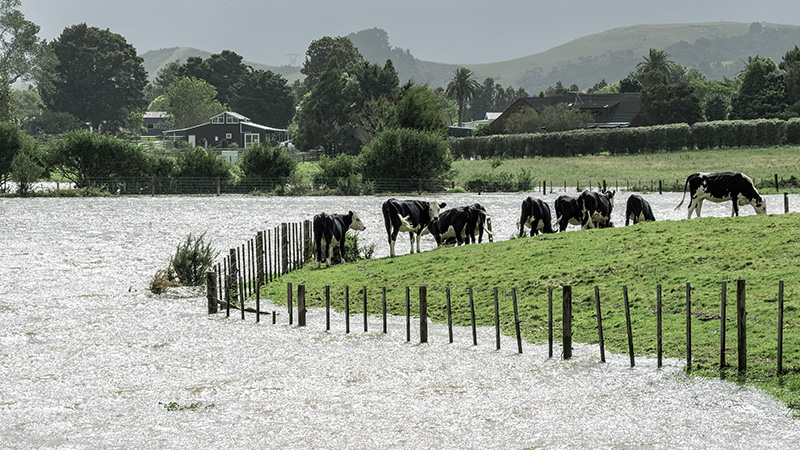Climate change, cyclones, and short-term thinking
Published in Bay Buzz
Humans aren’t great at long-term thinking. That’s because our brains are wired to react really well to immediate threats.
It wasn’t that long ago, in terms of human evolution, that we were mainly concerned with finding our next meal while avoiding becoming one.
Threats like being attacked by a predator have been replaced by other short-term worries. This is well illustrated by the latest Kantar Better Futures survey which found 72% of respondents put the immediate concern of rising cost of living as their main concern. Protecting New Zealand’s children was second, crime levels were third, availability of affordable housing was fourth, and fifth was violence in society.
Concern around the impact of climate change on Aotearoa New Zealand didn’t even enter the top 10, despite the knowledge it will have very real, and dire, economic and social impacts in the future.
And while the effects of extreme weather events did reach the top 10, driven by the January and February storms which lashed the North Island, this is likely to be short lived. The survey’s researchers noted that concern peaked and then dropped even over the period the survey was open.
It’s human nature to suppress traumatic events and experiences rather than dwell on them. The news media moves on from the stories of human tragedy. I am very hopeful though that decision makers will keep the impacts of Cyclone Gabrielle in mind when planning new developments, infrastructure or upgrading existing assets.
Immediate impact
Here in Hawke’s Bay, the scale of destruction left behind by Cyclone Gabrielle has given us a fresh, very stark perspective on our vulnerabilities and what extreme weather, turbo charged by climate change can do. It’s uprooted entire communities, brought long-term hardship to many and devastated the lives of those who lost loved ones.
In the immediate aftermath, sustainability was a secondary consideration to getting people safe, housed and fed, before tackling the destruction.
Some 200,000 truckloads (2,700,000 tonnes) of silt settled in the lower five kilometres of Esk Valley. At its peak the Esk river recorded 1.7 million litres of water a second at 3:45am. The Tutaekuri recorded 1.8 million litres, the Ngaruroro 2.9 million litres and the Tukituki 3.3 million litres a second at their peak. Truly astounding amounts of water.
The sheer volume of waste to be dealt with overwhelms all our existing systems, but those systems themselves were also compromised. For example, the Ōmarunui Landfill, a facility that serves the whole of Hastings and Napier had its kiosk washed off its piles, and weighbridges were full of silt. Commercial composter BioRich, which processes a significant quantity of the region’s organic waste, was badly flooded. Recycling trucks and facilities were compromised. Damaged roads meant even getting to these facilities was not possible for an extended period.
The sheer volume of waste created was difficult to wrap your head around, even for someone like me who has spent their career in the waste sector.
Household waste needs were dwarfed by the acres of orchard wires, strainers, posts, bird netting, trees, vehicles, slash and animal carcasses all rolled into one mass.
Material that would normally have been recyclable or compostable are destined for landfill due to contamination. Serious consideration is being given to legislation to allow controlled open-air burning of waste.
Construction and demolition waste already makes up around 50% of all waste going to landfill. With over 2,100 homes red or yellow stickered, the scale of deconstruction and reconstruction will see that soar, with limited options for reuse and recycling due to both scale and contamination.
The challenge faced by the region’s waste management officers and crews has been immense. They have worked long hours under huge pressure and had to come up with innovative solutions very quickly – their work doesn’t go unappreciated.
There are ideas emerging. Can slash for example be shredded and mixed with silt to add nutrients value and create a soil additive? Some of our country’s most productive land is alluvial plain after all, but it’s a process that happened over millions of years.
Preparing for a different future
One in 200-year storms and floods are becoming one in 100, one in 50-year events. As we have seen they can hit many communities in quick succession, stretching resources. Coastal communities are already compromised. While there has been discussion about retreat from some coastal areas, inland communities are now also proving vulnerable.
It’s imperative we don’t miss the opportunity to improve prevention, mitigation and response initiatives. The Government review of forestry practices is a good start, but the appropriate use of land is a bigger conversation for this country with large impacts on our economy and jobs as well as our environment. We missed this opportunity after Cyclone Bola and we are now suffering the consequences.
There is much talk about whether pine planting is even a viable long term carbon sink, and criticism of how it reduces productive land. But what if we instead truly incentivised farmers to plant the most erosion prone areas of their land in permanent native forest, while retaining the most productive parts for farming.
The way we build infrastructure and where we place it can reduce its vulnerability. For example, telecommunications companies have been quick to recognise they need to build partnerships with satellite communications companies to back up terrestrial physical infrastructure. Moving landfills and substations away from waterways will need to be considered.
We will need to rethink our inclination to believe we can control where water wants to flow with stop banks and diversions. Instead of seeing wetlands as a barrier to development, we will need to consider incorporating them as natural flood control.
When it comes to building resilient housing, where we allow building is a major consideration. But so is how we build. There are already examples of future proofing working well when extreme weather strikes. One is the Earthsong Eco-Neighbourhood in Auckland, built 24 years ago to very high environmental sustainability standards.
It’s built to allow for the natural flow of water, uses a swale system to absorb rainwater, and has a pond. The medium density housing development is also designed as a ‘spongy neighbourhood’ with minimal paved areas and maximum green space, gardens and trees to absorb water and retain soil.
Another is the Richmond townhouse development in Mt Wellington which was built over an aquifer and was designed with an extensive stormwater system. It too survived the Auckland flooding unscathed, despite getting 30% more water than it was designed for.
Planning policy and Infrastructure spending shouldn’t be an election year lolly scramble or political point scoring. There needs to be cross-party agreement and consensus across all levels of government with input from communities on the priorities, the responsibilities, and the resources required to mitigate future effects of extreme weather over the long term.
We cannot afford to let the price paid by Hawke’s Bay, Auckland and Northland and our hard-learned lessons of the last few months be for nothing.







